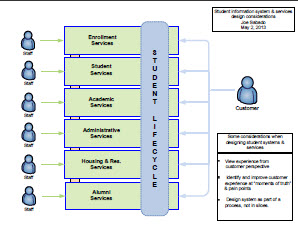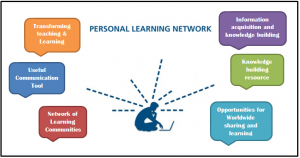I firmly believe that having some historical/theoretical knowledge and understanding of the purpose of student affairs have provided me a better perspective and appreciation of the use and impact of technology in student affairs. The knowledge and understanding have helped me in my role as a technology implementer/user for the Division of Student Affairs at UC Santa Barbara. I became familiar with contemporary issues, student development theories, history, and principles of student affairs through self-directed learning by reading textbooks, social media, and engaging with my personal learning network. It is with this perspective and background that I think about what would a course on technology in student affairs. What elements should this course contain so all student affairs professionals, regardless of their educational and previous professional background can use technology within the purpose of student affairs?
The idea of designing a course about technology in student affairs entered my mind from time to time the last few months but I never really committed to exploring what this course would even look like. I just recently began to explore this idea again as a result of my involvement with a professional development committee charged with defining the curriculum for new student affairs professionals at UCSB. I would like to include an introductory course about technology in student affairs as a part of the curriculum. One of the goals of the 1 year cohort-based program is to set a foundation of core competencies. The intended audiences are:
- Professionals who recently completed student affairs graduate programs
- Professionals who have student affairs administrative experience, but without formal student affairs graduate training
- Professionals newly entering students affairs from other industries or fields within higher education
What I find interesting is that based on this post by Eric Stoller, it seems student affairs graduate programs do not offer courses in technology. This is an issue that Eric has raised for discussion several times. What topics then should be included in a technology course to provide new professionals theoretical/practical knowledge to do their job effectively?
Here are some elements I think should be considered given the audience and the purpose of providing theoretical/practical knowledge to new student affairs professionals:
General Introduction to Student Affairs (Principles, History). Effective use of technology in student affairs must start with understanding how technology should be used with the purpose of student affairs in mind. Ideally, it would also be nice to have an overview of the history/purpose of the student affairs on the audience’s campus.
Student Development/Ecology Theories. Theories can serve as guides to understanding how technology impacts student learning and personal development. How technology impacts digital identity, student engagement, retention, and learning are key issues
History of Technology in Student Affairs. I have read Kevin Guidry’s research on the history of student affairs technology including the topic of technology as a competency and his research provided me a greater appreciation of how technology has impacted the student affairs profession as way back as the 1920’s. Social media, mobile, and cloud computing are the technologies used today but I think it’s important to recognize the evolution of technology as drivers and as tools to accommodate the needs given the time periods.
Innovation and Change Management. Most of the issues I have encountered (and requiring most attention) throughout my years of implementing technology solutions have not been the technologies themselves. Effectively communicating changes, managing people’s expectations and dealing with stress/conflicts resulting from ambiguities and uncertainties have been keys to successful projects. Some participants in this course may be leading/implementing technology projects in the futures and most certainly, all participants will be impacted by the introduction of new technologies as end-users.
Assessment. The effectiveness/impact of technology use should be measured for the purpose of accountability and improving its use with respect to the programs/services it is being applied.
Frameworks for understanding technology use. This document, “Guidelines for Creating Student Services Online“, categorizes the different uses of technology to provide online student services. Technology is also used throughout student affairs for administrative and employee support services. Viewing technology use from different perspectives can provide the audience wi
Current and Future of Student Affairs and How to Prepare/Adapt. Student affairs does not exist in a vacuum. Globalization, internationalization, economic changes, changing demographics, and technological advances are just a few variables impacting the role of student affairs in higher education. How do we, as a profession and as individuals, prepare ourselves so we can adapt to meet the changes? How can we better understand the needs/wants of our current students and how do we tailor technology to meet them?
Ethics/Legal/Confidentiality Considerations. As end-users, educators and providers, we need to practice appropriate and ethical use of technology and within the boundaries of campus, state, federal policies/guidelines. Part of this discussion includes developing decision-making frameworks
in navigating between policies and practices that may well be in conflict with each other.
Ideally, this course should be flexible enough to be offered as a one-day introductory course or as part of a masters program curriculum. Content can either be expanded or some may be excluded/generalized depending on the purpose of the course. While this course is intended for new professionals, those who have in student affairs for years could benefit from this course.
What other elements would you add? How should the course be organized?
Ideas for this course came from links provided within the post as well as the following:

